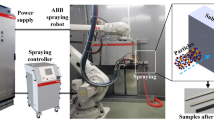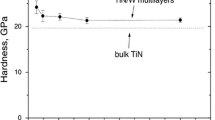Abstract
Ceramic/metal, ceramic/ceramic, and ceramic/polymer bilayers are prepared to find the best design for a reliable material. The transparent bilayer enablesin situ observation of crack initiation. The elastic modulus of the substrate material in the bilayer is controlled from 2.35 GPa to 230 GPa by using different compositions of glass, metal, and polymer. The thickness of the ceramic coating layer is controlled from 120 μm to 5.6 mm. The surface of the coating material is abraded to control the strength and toughness. Classical cone cracks and transverse radial cracks are observed during Hertzian indentation. The crack initiations depend on not only material design parameters such as strength, toughness, and elastic modulus but also geometrical parameters such as coating thickness. Conditions for avoiding cracking are considered, in terms of the material and geometrical design parameters.
Similar content being viewed by others
References
J. C. Knight, T. F. Page and I. M. Hutchings,Thin Solid Films 177, 117 (1989).
M. V. Swain and J. Mencik,Thin Solid Films 253, 204 (1994).
A. Pajares, L. Wei, B. R. Lawn, N. P. Padture and C. C. Berndt,Mater. Sci. Eng. A 208, 158 (1996).
A. Pajares, L. Wei, B. R. Lawn and C. C. Berndt,J. Am. Ceram. Soc. 79, 1907 (1996).
H. M. Chan,Ann. Rev. Mater. Sci. 27, 249 (1997).
S. J. Bennison, A. Jagota and C. A. Smith,J. Am. Ceram. Soc. 82, 1761 (1999).
Y. G. Jung, S. Wuttiphan, I. M. Peterson and B. R. Lawn,J. Dent. Res. 78, 887 (1999).
A. H. Bartlett and R. D. Maschio,J. Am. Ceram. Soc. 78, 1018 (1995).
S. Wuttiphan, B. R. Lawn and N. P. Padture,J. Am. Ceram. Soc. 79, 634 (1996).
K. S. Lee, S. Wuttiphan, X. Z. Hu, S. K. Lee and B. R. Lawn,J. Am. Ceram. Soc. 81, 571 (1998).
K. S. Lee, S. K. Lee, D. K. Kim and B. R. Lawn,J. Am. Ceram. Soc. 81, 2394 (1998).
H. Chai, B. R. Lawn and S. Wuttiphan,J. Mater. Res. 14, 3805 (1999).
A. G. Evans and J. W. Hutchinson,Int. J. Solids. Struct. 20, 455 (1984).
J. W. Hutchinson and Z. Suo,Adv. Appl. Mech. 29, 64 (1991).
H. Zhao, X. Z. Hu, M. B. Bush and B. R. Lawn,J. Mater. Res. 15, 676 (2000).
B. R. Lawn,J. Am. Ceram. Soc. 81, 1977 (1998).
D. B. Marshall, T. Noma and A. G. Evans,J. Am. Ceram. Soc. 65, C175 (1982).
B. R. Lawn,Fracture of Brittle Solids, Cambridge Univ. Press, Cambridge (1993).
Author information
Authors and Affiliations
Rights and permissions
About this article
Cite this article
Lee, K.S., Woo, S.K., Han, M.H. et al. Material and geometrical design for high reliability bilayer. Met. Mater. Int. 7, 531–537 (2001). https://doi.org/10.1007/BF03179250
Issue Date:
DOI: https://doi.org/10.1007/BF03179250




